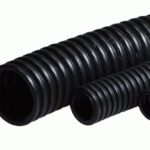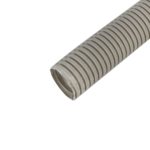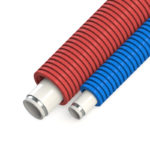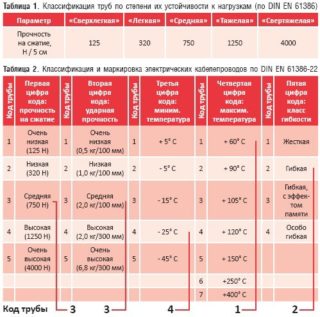Corrugation for wires in accordance with the rules for installing electrical equipment is installed when laying low-current networks and wiring. This is due to safety measures, since the corrugated pipe for the cable is an excellent dielectric and protects the wires from mechanical and thermal effects. Thus, the corrugation for wiring is additional insulation.
The purpose of the corrugation in the wiring
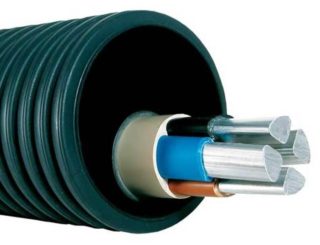
Corrugation can be called one of the most useful and sought-after inventions. Its characteristic feature is its variable cross-section. The pipe has short sections with small diameter and thin walls, as well as sections with large diameter and thick walls. The latter add rigidity to the pipe, its resistance to mechanical stress increases, and the former allow it to take on various shapes and even stretch within certain limits.
Due to its strength and flexibility, the product is widely used not only for electrical wiring, but also in exhaust ducts and ventilation systems, in split systems and air conditioners for condensate drainage, in plumbing for connecting drain siphons to the sewerage system, in the automotive industry. For electrical cables, a special wiring corrugation made of PVC is used.
Product design
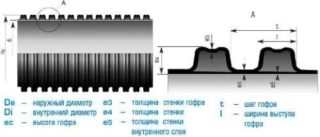
If the electrical hose is cut lengthwise, the profile will be rectangular. The main distinguishing feature of the product is the presence of a broach in the inner cavity (thin steel wire - a probe designed to pull bundles into the pipe). For wires, as a rule, the pipe has a gray color, but foreign corrugations come in red and blue shades.
Corrugations are metal, but more often they are made of plastic. This is due to the more acceptable cost of the material.
Advantages of electric corrugation
Corrugated pipes for electrical wiring are in great demand, and in some cases are mandatory due to the following advantageous features:
- Long operational life. Subject to the installation rules and careful attitude, the service life exceeds 50 years, all the properties of the material are preserved.
- Light weight, which greatly facilitates the process of transportation and subsequent installation.
- If a rubber gasket is installed at the junction of the parts, do not be afraid of moisture getting under the pipe, the material itself is waterproof.
- The material is environmentally friendly, does not decompose after years into individual components, does not harm human health.
- Non-combustible corrugation for wiring has excellent thermal shock resistance.
- The material of manufacture does not oxidize, does not corrode.
- High resistance to mechanical stress.
- Does not react chemically with active chemicals.
- The operating temperature ranges from -20 to +60 degrees.
Among the shortcomings, it is worth noting that at temperatures below -20 degrees, polyethylene pipes can burst.
Types and types of tubes
Various types of pipes are produced, since they are used for UTP cable, power, television and telephone, as well as for underground, hidden and outdoor wiring.They differ in performance, design and material of manufacture.
In the manufacture of corrugations, the following materials are used:
- Polyamide (PA). The advantage of the material is its extremely reliable waterproofing.
- Polyvinyl chloride (PVC) is in demand due to its self-extinguishing properties.
- Polypropylene (PP) - used for laying in electrically conductive trenches during the construction phase using monolithic technology.
- Low-pressure polyethylene (HDPE) - this material is the most flexible of all existing analogues.
- High pressure polyethylene (LDPE) - used for laying hidden wiring in foam block, concrete, brick and other materials that are not subject to combustion.
When laying wiring in a corrugation on a wooden ceiling, reinforced metal heat-resistant materials are used. Under other circumstances, it is impractical to mount a metal hose due to its high cost.
There is also a decorative pipe, but it is practically not used for electrical wiring.
For various conditions of use and installation, the following types of corrugated hoses for electrical wiring are made:
- Heavy - This variety has thicker walls, which greatly increases the durability and strength of the product. A pipe is used for installation under a cement-concrete screed.
- Light type are used for internal wiring. These hoses offer excellent flexibility due to their low wall thickness. Most often they are installed under drywall or other cladding.
So that the introduction of wires into the corrugation does not cause difficulties, the latter is additionally equipped with steel wire - a probe located inside the cable.
Diameter and packaging
The ratio of the outer and inner diameters of the corrugations for wires made of different materials is shown in the table.
| Metal corrugations | Non-flammable plastic corrugations | ||
| Outer surface diameter (mm) | Inner surface diameter (mm) | Outer surface diameter (mm) | Inner surface diameter (mm) |
| 9,8 | 5,1 | 16 | 10,7 |
| 11 | 7,7 | 20 | 14,1 |
| 13,5 | 9,7 | 25 | 18,3 |
| 15,6 | 11,7 | 32 | 24,5 |
| 19 | 14,7 | 40 | 31,5 |
| 22 | 18 | 50 | 39,6 |
| 30,3 | 24,5 | ||
| 38 | 31,5 | ||
| 45 | 37,5 | ||
| 58 | 49,5 | ||
| 71,5 | 62,5 | ||
| 87,5 | 78 | ||
A building product is sold in bays. The length of the light type can vary from 50 to 100 meters, and the length of the heavy 2 to 25 meters. For ease of transportation at the factory, they are packed in a shrink film made of polyethylene.
Criteria for choosing corrugations for electricians
Selection criteria, relying on which, it will be possible to choose a suitable product:
- The accompanying document always contains information about the flexibility of the pipe, but despite this, you need to personally check this.
- Modern hoses for electrical cables are produced with the calculation of permissible loads in the range of 125 - 4,000 Newtons / cm2.
- The operating temperature ranges from -50 to +420 degrees.
It is important to take into account not only static, but also shock effects. In serial corrugated pipes, the maximum threshold is 6.7 kg per 100 mm2.
Installation features
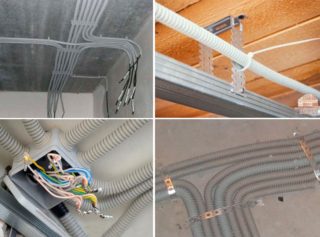
The installation of corrugated pipes has several stages, the main ones being the laying of the electrical cable and the fastening of pipes with wiring to the surfaces, it is also worth considering the most common difficulties that arise when using products.
Installation of corrugation is divided into two types - open and closed. Each has its own characteristics.
- In the first case, to fix the hose, you need to use special plastic clips. They come in different sizes, the choice depends on the diameter of the corrugated pipes used.
- Clips are placed at intervals of 30-40 cm. They are attached to the surfaces using self-tapping screws or dowel screws. The choice depends on the material from which the surface is made (concrete, brick, wood, etc.).
- The pipe is securely fixed in clips. To do this, the corrugation is pressed into the clip until a characteristic click appears.With correctly selected dimensions, the likelihood of spontaneous pipe falling out is excluded.
- With hidden installation, clips can be used, but this is very inconvenient, since they take up a lot of space. An exception is the installation of a corrugated pipe in a screed, on top of which a large layer of building mixtures will be applied to hide all irregularities.
- For installation in walls, use dowel ties, plastic staples or any homemade options cut from thin sheet metal.
When designing the path where the wiring will be carried out, the following points should be taken into account:
- The length of each individual section should not exceed 25 meters, the permissible number of turns is 4.
- Turns should not be close to each other, the optimal interval is 4-5 meters. If this is not possible, a junction box is additionally installed.
- The maximum possible turning radius is 90 degrees, but the smoother the better.
There are no difficulties in installing corrugated pipes with electrical wiring. During the work, it is important to observe personal safety precautions - the power supply is turned off, the voltage is checked.

